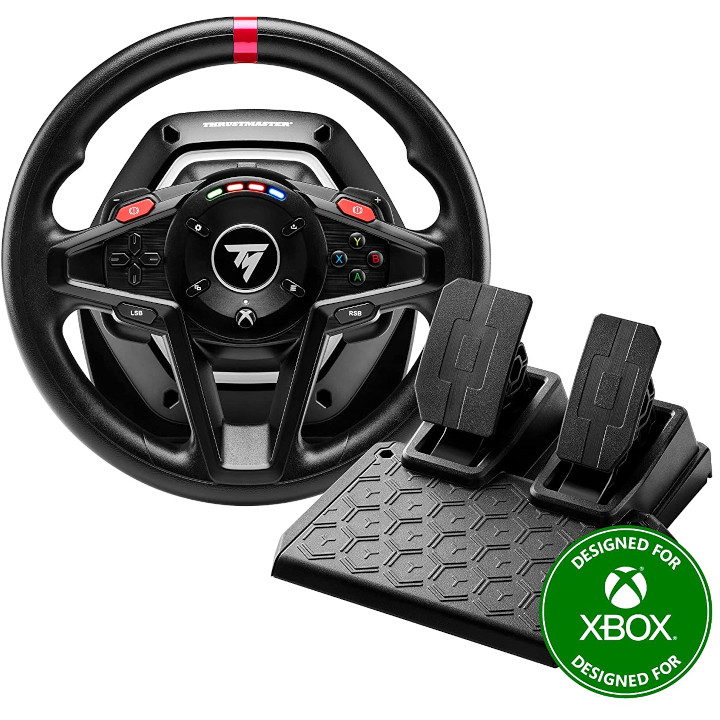Finding an affordable entry into at-home sim racing can be tricky. Racing wheels aren’t known for being cheap, and hundreds of variations exist. Anyone craving the experience of arcade racing or the chance to dabble in realistic simulation should be able to do so without breaking the bank or settling for the absolute bargain basement option.
Thrustmaster looks to cover this middle ground of affordability, cutting costs in the right places while offering a healthy amount of realism. The new T128 has more in common with its mid-range counterparts than anything at the bottom, so I took it for a spin over the weekend for our Thrustmaster T128 racing wheel review to see if it’s worth spending a little more.
Thrustmaster T128: Price and availability
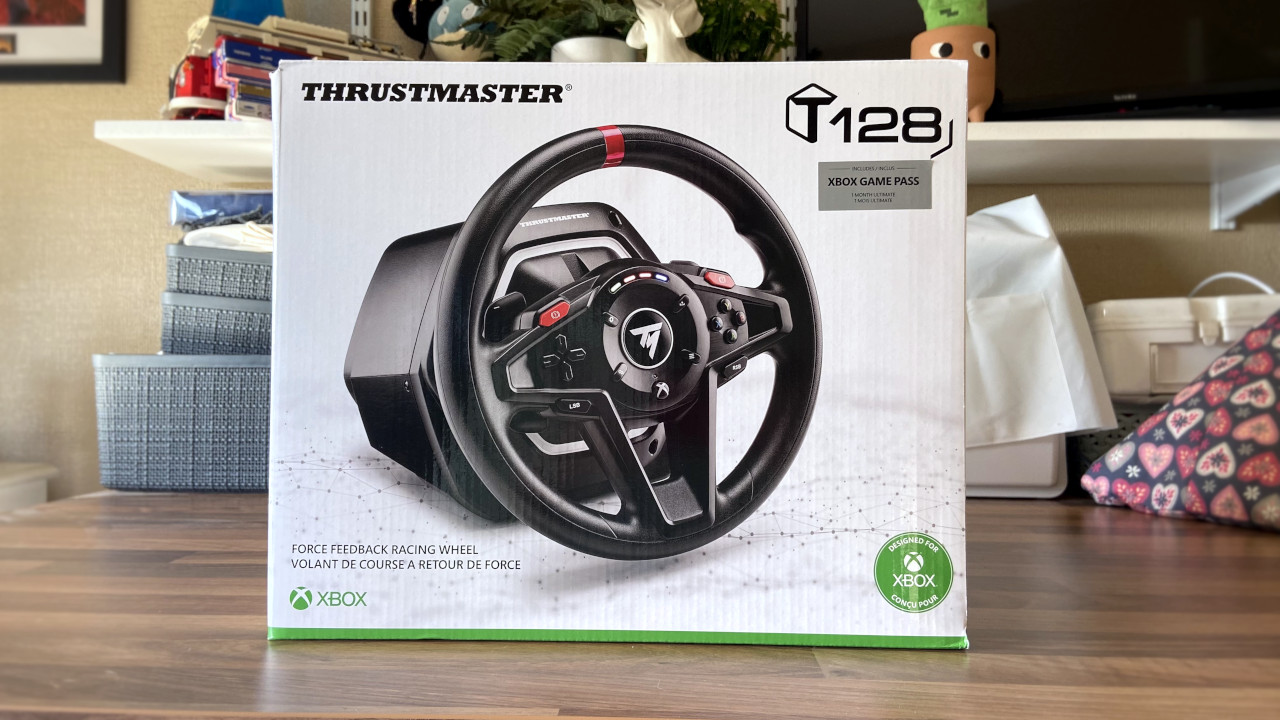
Thrustmaster sells the T128 racing wheel through third-party retailers, including Amazon, for a $199 MSRP. Compatible with Xbox consoles and PC using the included USB-C cable, it comes boxed with a set of Thrustmaster T2PM hall-effect sensor pedals that connect to the servo base with an RJ11 cable. A PlayStation variant is set for release on October 27 and will also be compatible with PC.
Thrustmaster T128: What’s good
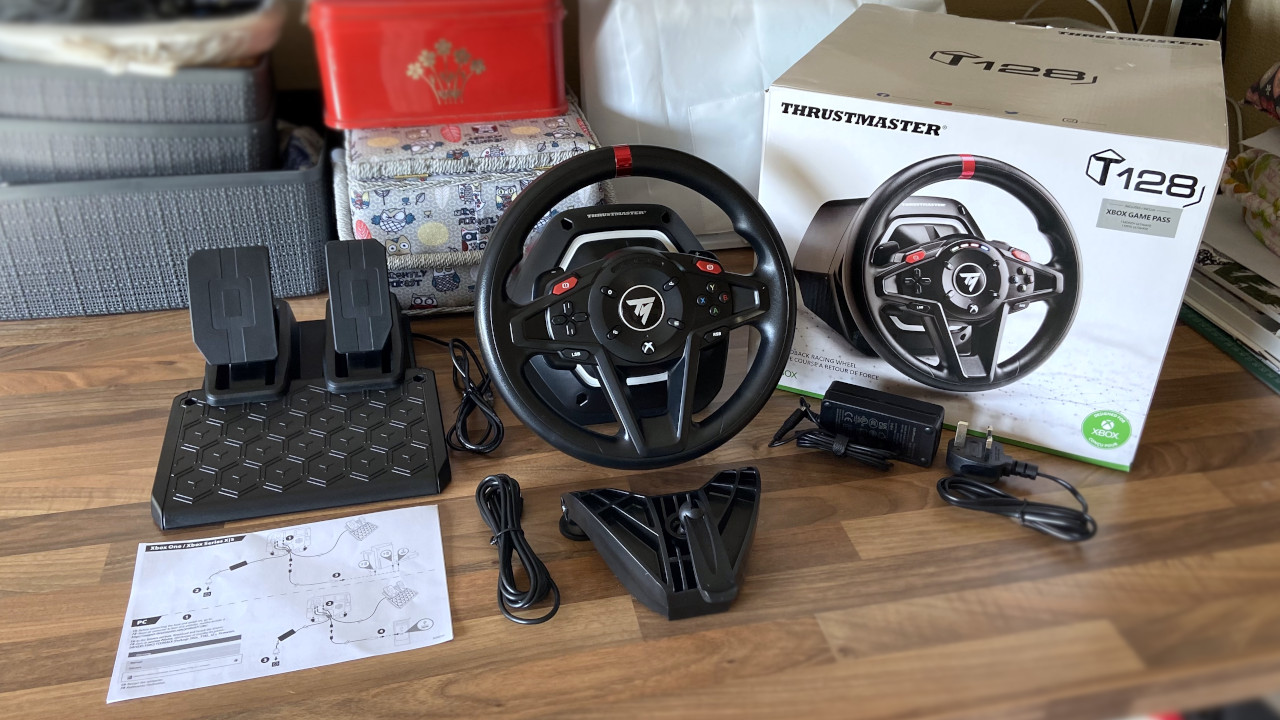
Thrustmaster has repeatedly impressed me with its wide range of peripherals, causing somewhat of a minor obsession with racing wheels in the past year or so. Though I dabble in some serious simulation titles, I find mid-range models more comfortable than most ultra-high-spec professional wheels, as exciting as they are. Still, convincing friends to pick up a niche peripheral to try an evening of Euro Truck Simulator 2 is a little tricky, and selling newcomers on a complete iRacing rig is even harder.
Since I don’t have much space for a cockpit setup, lightweight racing wheels with simple table clamps come under particularly intense scrutiny as I need to clear them out of the way when it’s time to work. Upon receiving the T128 wheel, I wondered what corners might have been cut to build a more affordable force feedback wheel. Thankfully, similarities to the fantastic Thrustmaster T248X wheel are immediately apparent, so we’re off to a good start.
The design of the wheel makes it clear where the T128 found its name since it’s a slightly stripped-back version of its predecessor, lacking only a couple of buttons and the T248X’s iconic HUD display. Past that, the servo base and its connections are functionally identical. A USB-C cable connects the unit to your console or PC, an RJ11 cable to the included T2PM two-pedal set, space for the AC power adapter, and a mini-DIM port for compatible gear shifters, handbrakes, and anything else you might have.
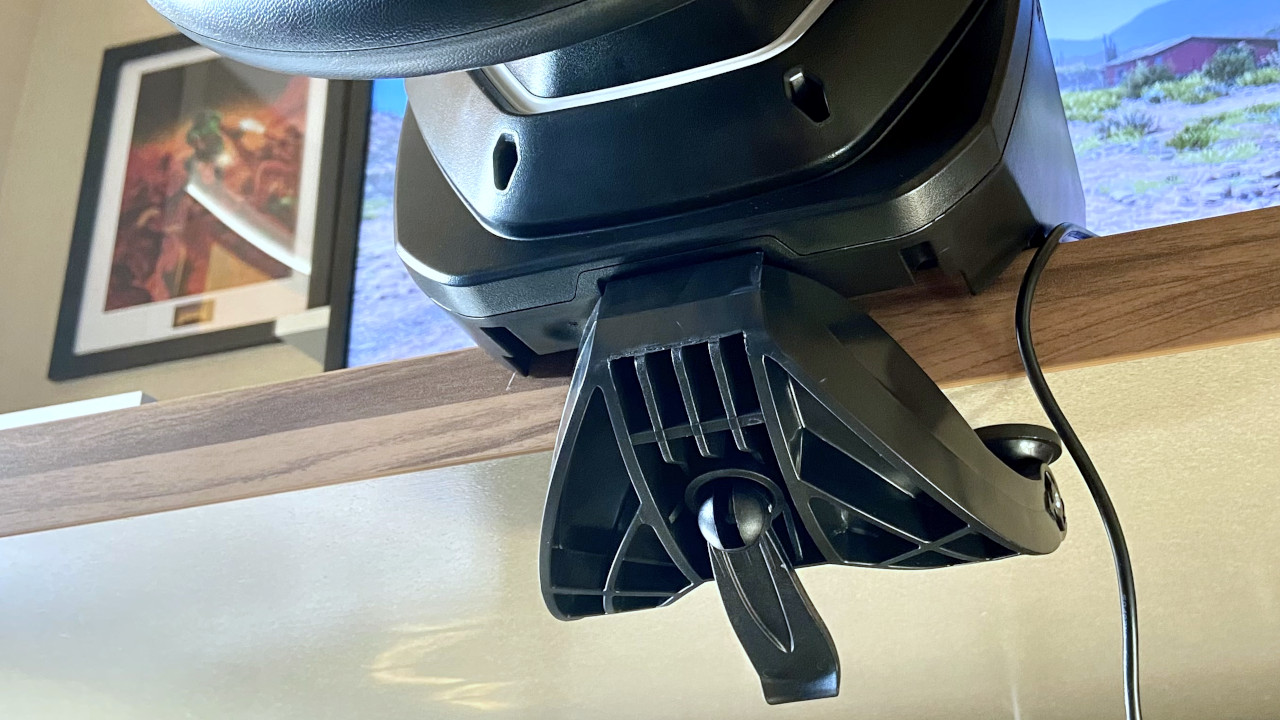
The table clamp works as you would expect, the same as a microphone arm or one of those flexible tablet holders I use to play Xbox Cloud Gaming in bed. Its adjustable feet twist into position, holding steady with rubber grip feet. Holding the servo in place with an overhang notch, the T128 has an effortless setup with the tried and tested Thrustmaster clamp.
The T128 is totally plug-and-play on Xbox, with all my usual games detecting every button and the pedals perfectly.
As you can tell by the face buttons, our provided T128 model is primarily designed for Xbox use, but both variants are compatible with PC, too.
As soon as I connect it to my Series S console, the wheel automatically calibrates its rotation and center point. Seeing them suddenly spin left and right can be surprising if you’re not used to racing wheels, but it’s much easier than manual configuration.
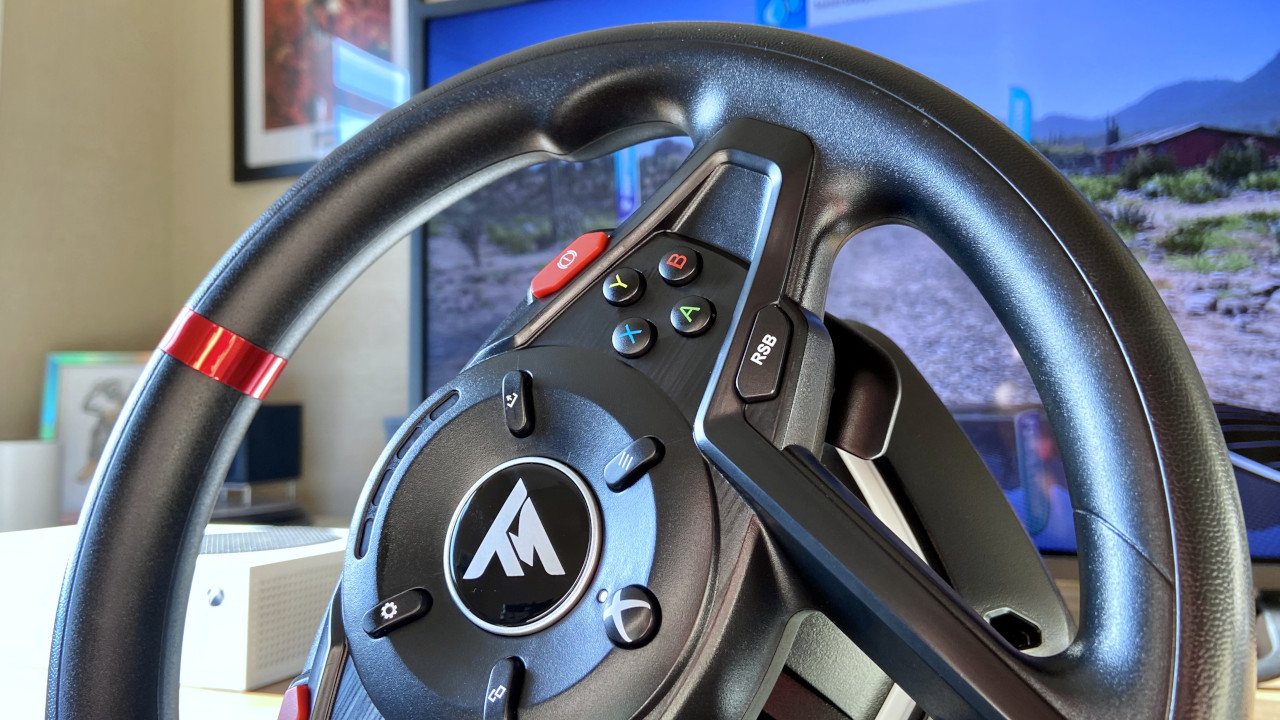
The T128 is totally plug-and-play on Xbox, with all my usual games detecting every button and the pedals perfectly. A PC can detect raw input by simply connecting the wheel via USB, but the official Thrustmaster control panel app has more customization options. If you want to fine-tune the force feedback and damper effects, you’ll need a Windows desktop or laptop to hand.
Spending a few hours in Forza Horizon 5 with in-game settings adjusted, I switched the wheel over to my laptop a few times to make tiny adjustments until everything felt right. It might not be as quick to react as some of its more expensive competitors, but I was impressed with the performance of the T128. The mirrored handbrake buttons come in clutch for casual drifting, and the hall-effect paddles are better than some high-end models I’ve used.
Dropping the HUD from its T248X counterpart is a shame, but the engine speed LEDs make up for it. They’re bright and colorful enough to notice in my peripheral vision, making manual gear shifting a breeze. Considering I usually stick to automatics in arcade racers, I had a lot of fun hitting perfect gear changes with the T128.
Thrustmaster T128: What’s not so good
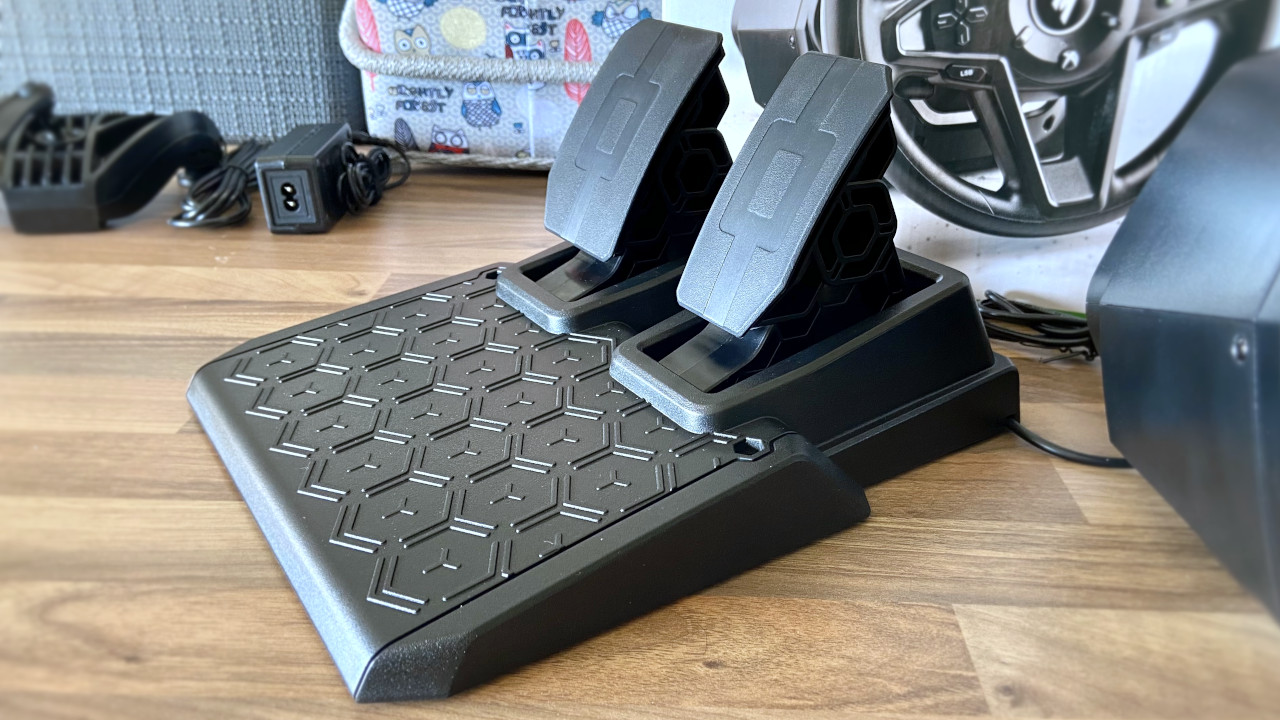
The most severe cost-saving effects are felt in the T2PM pedals, which are so lightweight and compact that they resemble a plastic toy more than a sim peripheral. Both pedals are placed extremely close together, so anyone with larger feet who like to play with their shoes might find the edges of their soles rubbing together, as I did with any left-foot braking.
Placing them against a solid surface is critical if you’re playing on a carpet, which might not be possible in your setup due to a woefully short cable connecting the pedal set to the servo base. The T128 wheel is entirely plastic, too, but the build quality is far better than the hollow pedals, and you’ll soon be clamoring for a higher-quality replacement like the Thrustmaster T-LCM magnetic set.
For casual gamers, the target audience here, the pedals are at least serviceable with a decent spring behind the brake. Still, though they are the weakest feature of the whole set, it’s better than absolutely nothing. Cutting any more elements from the wheel would ruin the tremendous value of the T128, so the pedals took the brunt of Thrustmaster’s belt-tightening initiative.
Past the pedals, there aren’t any severe negatives to the wheel. You get what you pay for and even a little more, with the downsides mainly remedied with replacements and careful tuning with the control panel software. It’s tricky to recommend the T128 to gamers with experience in the sim racing scene unless they already have a significantly inferior wheel since this kit is far better suited to first-time buyers.
Thrustmaster T128: The competition
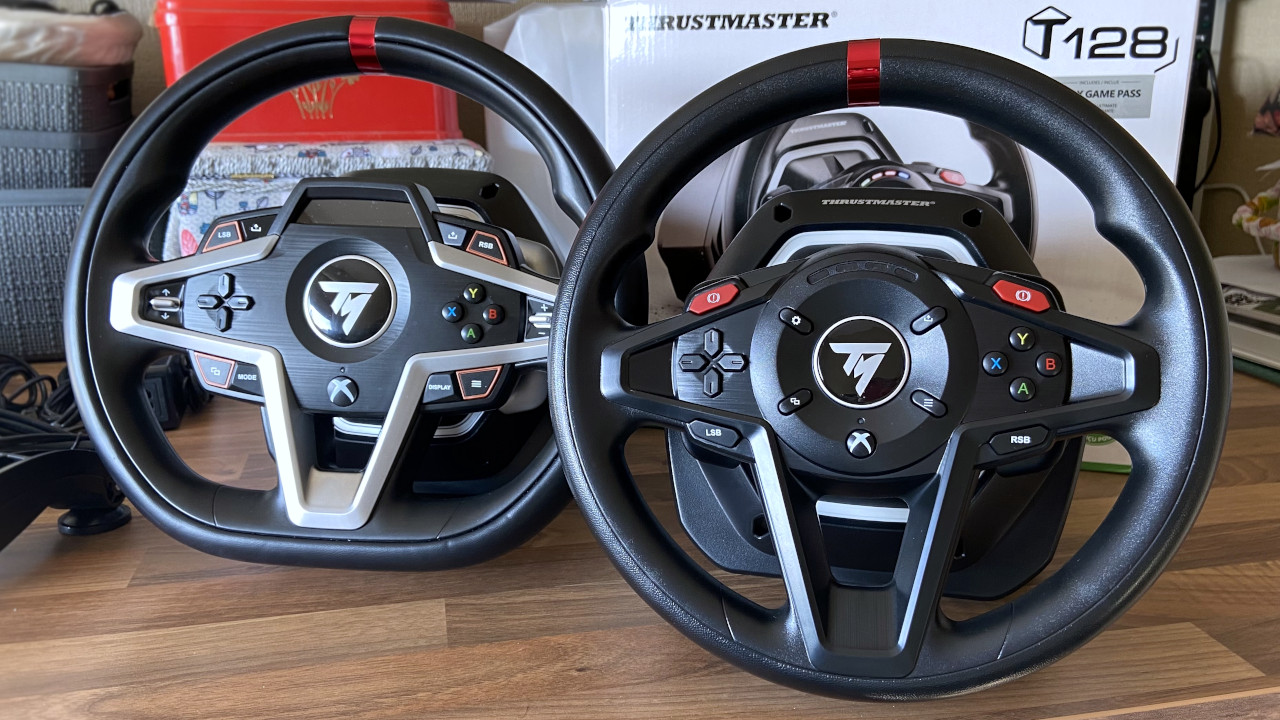
For just under $200, the T128 offers incredible value, considering its similarities to the Thrustmaster T248, which generally retails for twice the price. Features like the face buttons feel identical to its more expensive sibling, and improvements to the gear-shifting paddles make them more comfortable to use with less of a clunky sound.
The T128 offers an incredible saving for a curious newcomer interested in the simplest simulation games.
The T2PM pedals can’t compete with the sturdy T3PM magnetic set packaged with the T248. Still, it’s an understandable compromise if dropping to two pedals with a plastic construction contributes to a big $200 saving.
They’re good enough to get you started, and some casual gamers may be happy to stick with them; it all depends on the kinds of games you want to play and the level of realism you crave.
I still recommend the Thrustmaster T248 to everyone who asks me about racing wheels; it’s simply the most versatile hybrid-drive wheel that doesn’t cost the earth. Asking a curious newcomer to part ways with $400 to discover perhaps they’re only interested in the simplest simulation games is still a stretch, so the T128 offers an incredible saving for precisely that audience.
If the Logitech G29 could drop to the same $200 price point and stay there, it would be a serious competitor. Unfortunately, the G29 so far only temporarily hits this range during sales, so it’s less of a reasonable choice for impulsive buyers. A closer alternative would be Thrustmaster’s own TMX wheel, which recently disappeared from some retailers, leaving the T128 as the entry-level wheel of choice.
Thrustmaster T128: Should you buy?
You should buy this if …
- You’re a newcomer to simulation racing.
- You want to race on Xbox and PC.
- You’re on a tight budget.
You shouldn’t buy this if …
- You don’t have access to a Windows PC or laptop.
- You want a high-quality set of pedals.
Thrustmaster makes no illusions about the T128; this racing wheel is for casual newcomers looking for something more than a barebones wheel. Loaded with the same hybrid-drive force feedback as its mid-range T248, which retails for twice the price, the entry-level T128 doesn’t cheap out on immersion. It will easily step into the ranks of the best racing wheels for Xbox Series X|S, replacing the Thrustmaster TMX.
The all-plastic construction and no-frills T2PM pedal set demonstrate how costs were cut to hit this price range. Still, multi-colored engine speed LEDs are an excellent replacement for other sacrificed features, and it’s just as fun to use in various games. Perfect for first-time gamers wanting a thrilling experience, whether for high-speed racers or slow-paced simulators.


